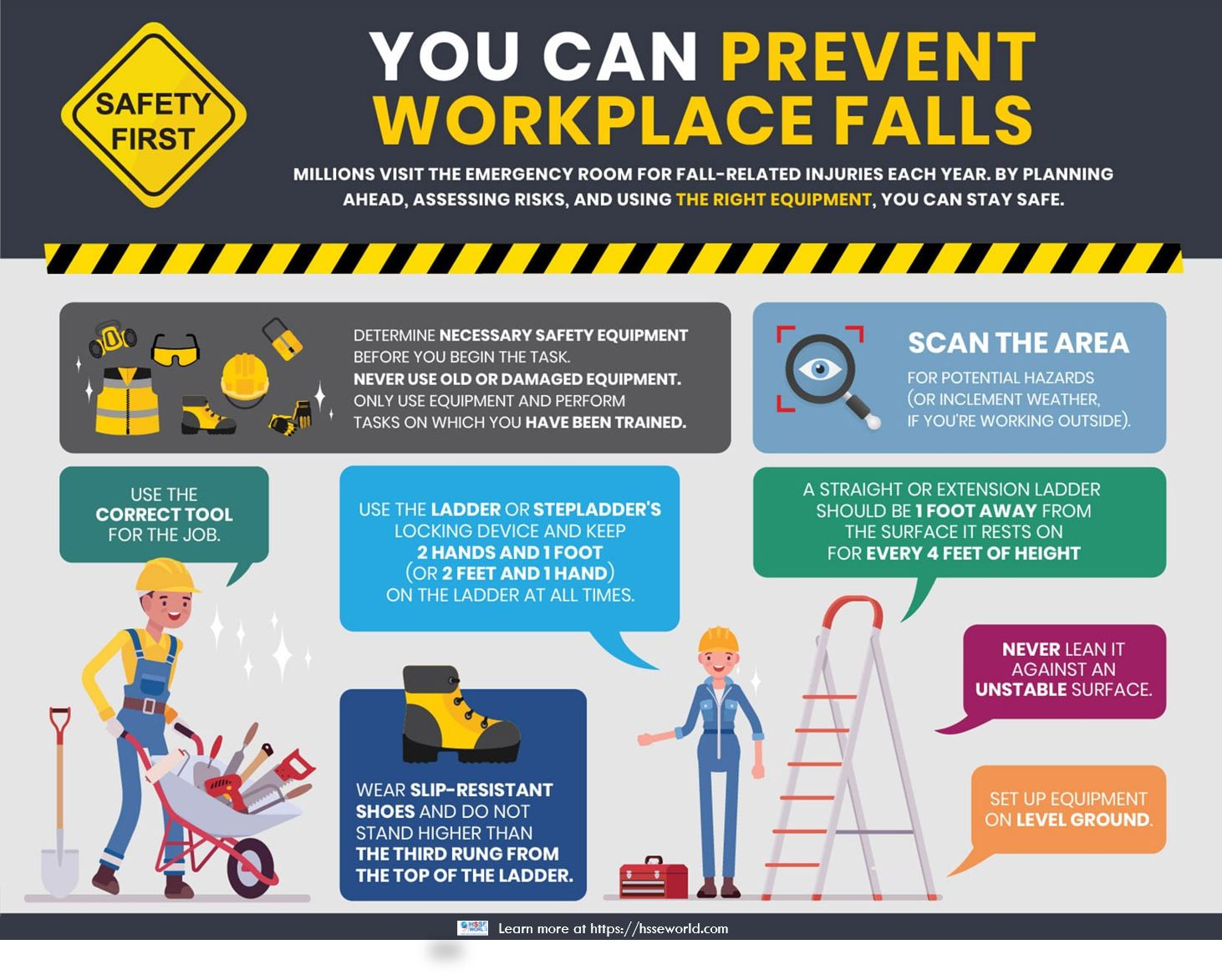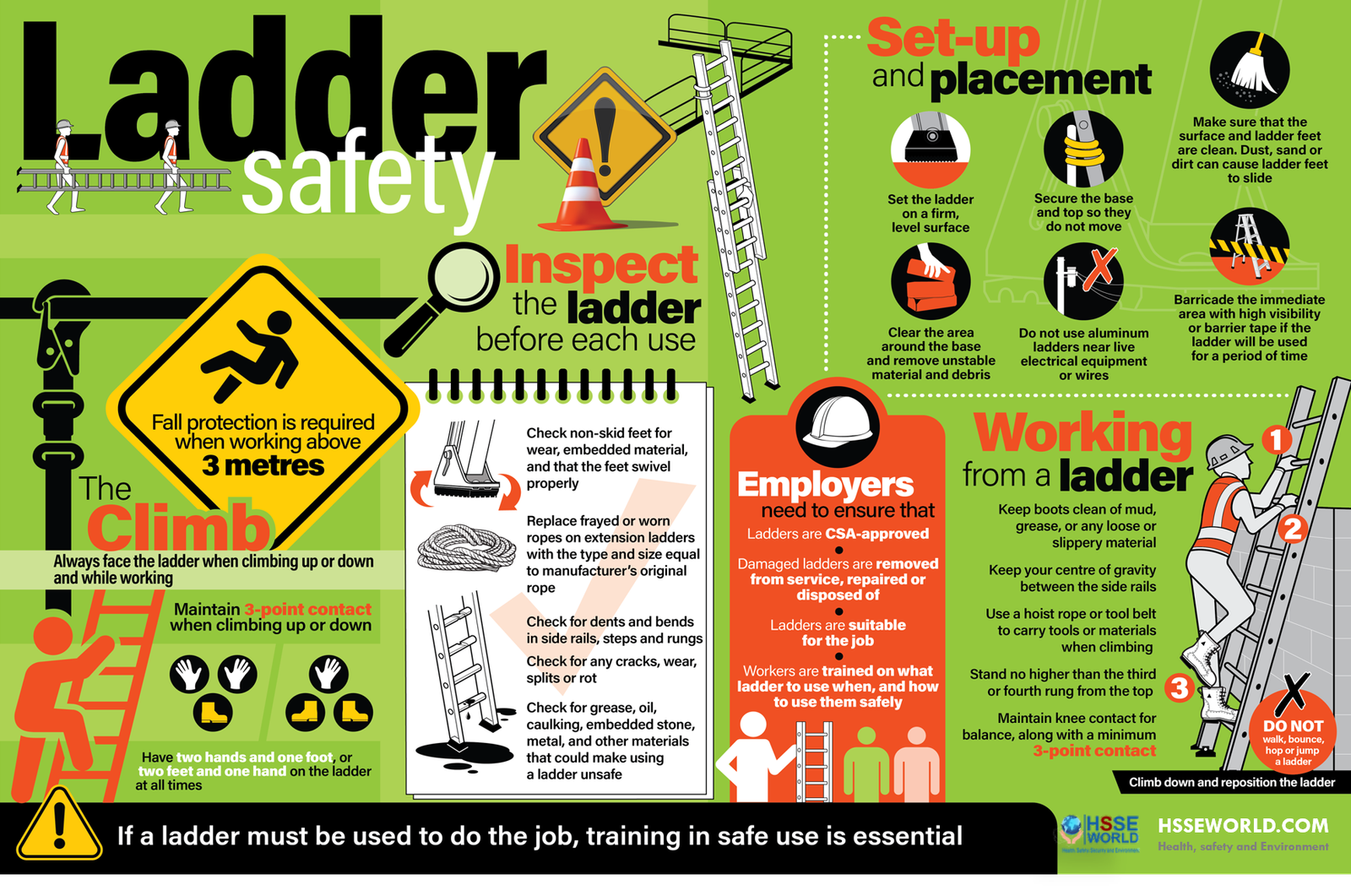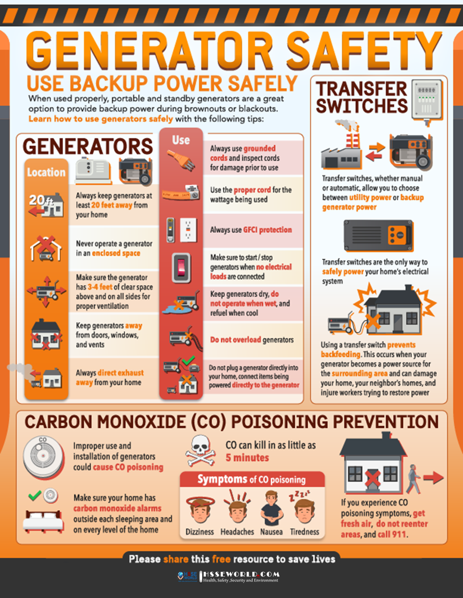Few people can claim they’ve never slipped, tripped, or fallen at least once in their lives. It happens to everyone at home, school, work, and play. Sometimes it can get a laugh out of bystanders but in reality, these types of accidents are dangerous, especially when it happens at work.
It only takes a second of not paying attention to slip on a wet floor, fall down a flight of stairs, or trip over protruding objects. Injuries can range from bruises and minor sprains to more serious ones requiring medical attention.

The U.S. Department of Labor reports that injuries due to slips, trips, and falls are the second-highest cause of days away from work. To put it into a financial perspective, an estimated 25 percent of reported injury claims are filed after an employee trip, slips, or falls. However, there are ways businesses can make the work environment a safer place for its employees.
How to Prevent Employee Injuries From Slips, Trips, & Falls
Slips, trips, and falls are the leading cause of general workplace accidents and injuries ranging from minor bruises to severe traumas such as head injuries, broken bones, sprains, and lacerations. In fact, slips, trips, and falls are often reported as the most common causes of workers’ compensation claims.
To reduce the potential hazards that lead to slips, trips, and falls, there are ways you can proactively manage your workplace environment to help lower the risk of injury to your employees and customers.
Here are ways you can prevent slips, trips, and falls around the workplace:
1. Create a Slips, Trips, and Falls Risk Assessment Plan
The first step is to understand that housekeeping and maintenance are an integral part of safety. Cleaning is the perfect opportunity to simultaneously conduct risk assessments, and both should be routine in your workplace, not something done right before an inspection or after an accident. An easy way to keep the business clean, organized, and risk-free is to create a plan.
- Assign specific responsibilities to individuals or teams. You also want to stress that each employee is responsible for picking up after him/herself.
- Once the duties are assigned and a routine has been written down, post the cleaning plan in an area that is easily accessible to employees.
It only takes a few steps to be proactive in workplace slip, trip, and fall prevention.
(learn more:why-housekeeping-is-an-important-part-of-loading-dock-safety/).
2. Keep Floors Clean and Dry
According to the National Floor Safety Institute (NFSI), 85% of worker’s compensation claims are attributed to employees slipping on slick floors. Floors get wet. Mopping and spills are just a couple of examples of what can make a floor slick. To prevent slips and falls, always put out a “wet floor” sign after mopping and spills.
If outside water frequently seeps in, moisture-absorbent mats can keep floors dry. Another option is to lay down the anti-skid adhesive tape. It provides additional traction on slippery surfaces. It works especially well on slight inclines often found in long hallways.
3. Remove Obstacles From Floors
Anything can be considered a trip hazard if it’s on the floor. Equipment, work materials, and everyday clutter can easily become obstacles on stairways, doorways, around corners, and on floors. To keep the workplace free of obstacles, it’s necessary to make it a policy to continuously check areas to ensure the floors, etc. are free from clutter.
Here are a few workplace storage safety tips:
- Keep service areas, storerooms, hallways, and workstations clean and clutter-free
- Do not leave hose, cables, wires, etc. laying across floors when not in use
- Avoid leaving briefcase, files, boxes, etc. laying in walkways
- Close all doors and drawers when not being used
4. Maintain Adequate Lighting Throughout the Workplace
The risk of accidents from slips, trips, and falls at work increases when there isn’t adequate lighting. This includes all walkways, stairs, hallways, ramps, basements, and dock areas. If it is a construction site, every part must be well-lit at all times during work hours
It’s also important to remind employees to always turn on the lights first when they enter a dark room. This means you’ll want to make sure that all light switches are placed close to the door. Bulbs, cords, and light fixtures must also be repaired or replaced immediately when needed
(learn more:slips-trips-and-falls-prevention/)
5. Require Proper Footwear
Whether you work in an office, an automotive shop, or on construction sites, proper footwear is crucial to preventing slips, trips, and falls. Some industries require or even provide specialized footwear as part of the uniform code, but not all.
If safety shoes aren’t required, employees still need to consider their footwear. The soles should be non-slip, with plenty of traction. If heels are often worn, ensure that the shoes won’t get caught on the edge of a rug or other uneven surface. Employees also want to double-check to see if their shoelaces are tied.
(Learn more:safety-footwear-construction/).
6. Manage cords
Power, internet, and phone cords can often create a sea of obstacles for employees and customers. Try to run cables behind walls or under carpets to keep them hidden. Install power outlets, internet connections and phone jacks in easily-accessible locations to avoid running cables across walkways.
7. Signage
Using clear, well-placed signage can help call attention to potential problem areas. A sign indicating a step, gap, uneven ground, or loose rocks will call attention to the hazard and increase awareness and attentiveness. Using reflective tape can also highlight problem areas.
8. Step stools
Providing ladders and accessible step stools can help reduce the chances of a fall by helping employees reach heights safely. By ensuring supportive options are present, there is less of a chance that an employee (or customer) will decide to rely on unstable chairs, desks, or tables.
9. Check floor conditions, inside and out
Make sure there are no cracks or holes in building flooring or in the pavement outside. Repair any problem areas immediately and be sure to place warning signs in/on/around areas that need to be fixed.
10. Non-skid throw rugs on slippery surfaces
Do you have tiled or hardwood floors in splash-prone areas (e.g. bathrooms)? Adding non-skid throw rugs can help reduce accidents. Rugs are an easy solution on otherwise slippery surfaces, but just make sure to add non-skid padding underneath the rug to prevent it from slipping out from underneath someone.
11. Clean up spills immediately
If you have a spill, clean it up immediately. If allowed to penetrate the floor surface, some substances can actually create a more slippery surface even after cleanup. When a spill occurs, immediately place warning signs around the hazard and then tackle the cleanup process.
12. Create a Custom Plan With Work-Fit
It is impossible to prevent every slip, trip, or fall at work. Accidents can happen anywhere, but by taking proactive safety steps, many workplace injuries can be prevented. One of the best ways to make sure your team is protected is to bring in the experts.
Remember Falls are Preventable
While slips, trips, and falls can often be attributed to carelessness or clumsiness, the good news is that most accidents are preventable. It is critical to frequently survey your work environment to avoid potential issues. Remember, proactive attention to hazards will ultimately help keep your employees and customers safe and out of harm’s way.
Download the Infographic
More photos:
- What are the Best Practices for Managing Subcontractor Risk
- Photo of the day: 10 Essential Safety Tips for Driving in Hot Weather Conditions
- Photo of the day: best workplace safety tips
- Photo of the day: The Importance of Stop Work Authority in Maintaining Workplace Safety
- Photo of the day: Tomorrow’s Reward for Working Safely Today: Cultivating a Culture of Safety
- Photo of the day: Preventing slips and trips at work
- Photo of the day: Learn the DRSABCD action Plan
- Working with Electricity Electrical Accidents Guide for Electrical Workers
- Photo of the day: Hearing Protection Device Selection
- Photo of the day: If An Earthquake Shakes You-Infographic free
- Fire Safety Posters Free Download
- Photo of the day: First Aid for Electrical Burns-Infographic free
- Infographic: First Aid for Cuts and Scrapes free download
- Photo of The day: Work Safe with Lasers-Laser Safety free
- Photo of the day: Working Safely with chemicals and chemical Management
- Photo of the day: Safe work practices when using MEWPs ( updated)
- Photo of the day: Preventing Common Kitchen Hazards
- Photo of the day: Safe handling of Gas Cylinders and lecture bottles
- Photo of the day: Forklift Stability Triangle
- Photo of the day: Defective Tools Safe Work Practice
- Photo of the day: Lift With Your Legs Not With Your Back
- Photo of the day: First Aid for burns
- Photo of the day: The 7 Principles of HACCP
- Photo of the day: Working Safely with Suspended Loads
- Photo of the day: Heat Stroke First Aid and safety posters
- Photo of the day: Near-Miss Reporting and Posters
- Photo of the day: Ergonomic chair and office chair safety tips
- Photo of the day: Whole Body Vibration
- Photo of the day: Substation Safety Equipment
- Photo of the day: Bypassing Safety Controls Rules
- Photo of the day: Lightning Safety Tips
- Photo of the day: Overhead Power lines Clearance
- Photo of the day: Floor Marking
- Photo of the day: Types of Foot Protection
- Photo of the day: Types of Hand Protection
- Photo of the day: Lockout and Tagout Safety
- Photo of the day: Fall Protection Plans
- Photo of the day: Flood Safety Tips
- Photo of the day: Read All Labels Work safe
- Photo of the day: Run Project safely with Crane Hand Signals
- Photo of the day: Flagman and Traffic control
- Photo of the day: Managing Risks of Exposure to Solvents in the workplace
- Photo of the day: Scissor Lift Safety
- Photo of the day: HSE Bulletin Board
- Photo of the day: Arc-Fault Circuit Interrupters (AFCI)
- Photo of the day: Safe use of ladders and step ladders
- Photo of the day: Concrete Truck Driver Hand Signals
- Photo of the day: Extension Cord Safety Tips
- Photo of the day: Protect your Head
- Photo of the day: choosing the right Anchorage
- Photo of the day: Work-Related Asthma
- Photo of the day: Top FIVE Heavy Equipment Construction Site Safety Tips
- Photo of the day: sun safety in the workplace
- Photo of the day: Cannabis and Impairment in the Workplace
- Photo of the day: Position for safety and comfort-Safety Tips
- Photo of the day: Generator Safety
- Photo of the day: Controlling COVID-19 in the Workplace-Physical Barriers
- Photo of the day: Manual Material handling
- Photo of the day: Personal Protective Equipment last resort
- Photo of the day: WHMIS 2015 – Pictograms
- Photo of the day: Indoor Air Quality
- Photo of the day: Noise in the affected workplace
- Photo of the day: Fatigue at Work
- Photo of the day: Don’t be Driven to Distraction
- Photo of the day: working in heat and Humidex Rating
- How to use Plate Clamps Safely: Safety Moment#34
- Photo of the day: Sitting at work
- Photo of the day: 5 ways to reduce the risk of Slipping and Tripping
- Photo of the day: Preventing the spread of contagious illness
- Photo of the day: Incident Investigations
- Photo of the day: 10 Scaffold Safety Essentials
- Photo of the day: Effective Health and Safety Committees
- Photo of the day: New worker Orientation & Safety Orientation checklist
- Photo of the day: Workplace Inspection
- Photo of the day: musculoskeletal disorders
- Photo of the day: Emergency preparedness in the workplace
- Photo of the day: Mental health in the workplace
- Photo of the day: Trenching Safety Tips That Can Save a Life
- Photo of the day: Dangerous Goods Classes
- Photo of the day: Safety Equipment for Confined Spaces
- Photo of the day: Tips to reduce Heat stress in the workplace
- Photo of the day: hierarchy of controls
- Your steps to chemical safety
- H2S Gas and how to handle its Emergency
- Photo of the day: Importance of Mock drill and Fire Action Emergency Procedure
- Photo of the day: Choosing the Right Face Mask and the difference between a respirator and face mask
- Photo of the day: Confined space safety Precautions
- Breath Safely: The Proper Use of Respiratory Protection
- Photo of the day: Electric shock survival
- Photo of the day: Chemical Spill Emergency Response
- Photo of the day: Construction Site fire Safety
- Photo of the day: Confined Space rescue
- Photo of the day: Conveyors Safety Tips




